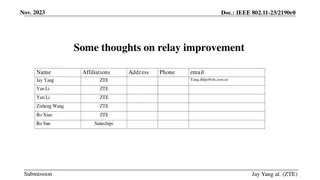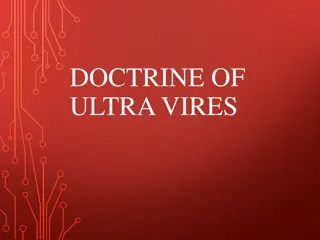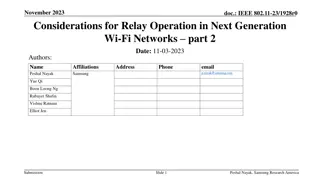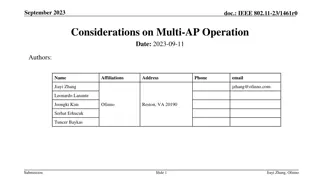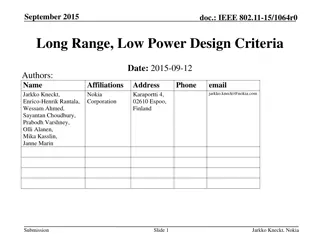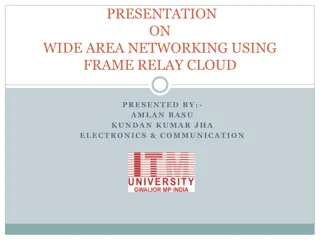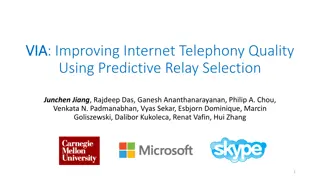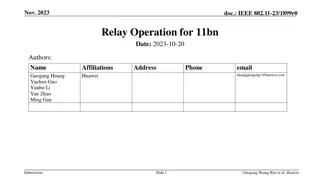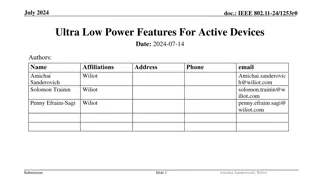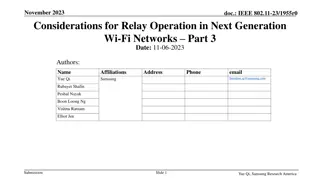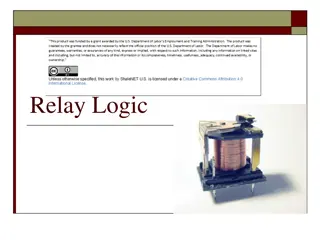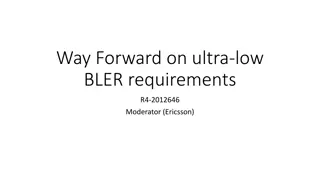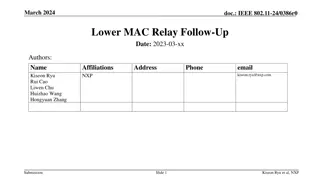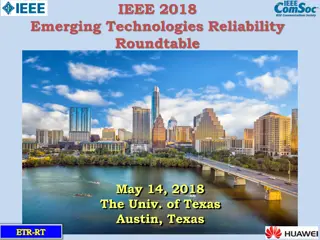Relay Communications for Ultra High Reliability in IEEE 802.11-22/1908r1
Investigating relay communications to enhance Rate-vs-Range (RvR) performance for Ultra High Reliability (UHR) in IEEE 802.11-22/1908r1. The content explores relay design objectives, goodput analysis, existing relay solutions like WiFi extenders, and the challenges in implementing relay technology to boost throughput and extend range.
Download Presentation

Please find below an Image/Link to download the presentation.
The content on the website is provided AS IS for your information and personal use only. It may not be sold, licensed, or shared on other websites without obtaining consent from the author.If you encounter any issues during the download, it is possible that the publisher has removed the file from their server.
You are allowed to download the files provided on this website for personal or commercial use, subject to the condition that they are used lawfully. All files are the property of their respective owners.
The content on the website is provided AS IS for your information and personal use only. It may not be sold, licensed, or shared on other websites without obtaining consent from the author.
E N D
Presentation Transcript
November 2022 doc.: IEEE 802.11-22/1908r1 UHR Rate-vs-Range Enhancement with Relay Date: 2022-11-13 Authors: Name Affiliations Address Phone email NXP Rui Cao 350 Holger Way, San Jose, CA 95134 rui.cao_2@nxp.com Liwen Chu liwen.chu@nxp.com Kiseon Ryu kiseon.ryu@nxp.com Hongyuan Zhang hongyuan.zhang@nxp.com Submission Slide 1 Rui Cao, etc. (NXP)
November 2022 doc.: IEEE 802.11-22/1908r1 Introduction Ultra High Reliability SG (UHR SG) was approved in July meeting with objectives [1] to improve reliability increase throughput at different SNR levels reduce latencies, etc. Some potential technologies are listed in [1~8]. Multi-AP coordination, managed P2P, link adaptation, etc. In this presentation, we investigate relay communications to enhance Rate-vs-Range (RvR) performance for UHR. Submission Slide 2 Rui Cao, etc. (NXP)
November 2022 doc.: IEEE 802.11-22/1908r1 Content Relay communications and use cases UHR relay design objectives Goodput analysis Submission Slide 3 Rui Cao, etc. (NXP)
November 2022 doc.: IEEE 802.11-22/1908r1 Relay Communications Relay link Relay STA Dest. STA Source STA B Direct link Higher propagation loss Boost throughput at range or extend range Relays retransmits/amplifies the source packet, multi-hop link Prominent per-hop SNR gain ~10dB better SNR with relay in the middle (pathloss exponent 3.5 for indoor) Extra SNR gain if relay avoids obstacles, e.g. 15~20dB loss per-wall Increase end-to-end throughput or extend range Design challenges: End-to-end channel reservation, latency/jitter: multiple channel accesses Relay processing delay and overhead lower rates: C= ? log(1 + ???) need relay Submission Slide 4 Rui Cao, etc. (NXP)
November 2022 doc.: IEEE 802.11-22/1908r1 Existing Relay Solutions WiFi extender (repeater/booster) Leverage the wireless distribution system (WDS) protocol Implements both client and (soft-) AP functions For the relay solution with co-channel wireless connection to main AP User experience suffers from end-to-end QoS (latency, jitter, throughput) due to hop-by-hop channel access and transmission control (BA/Security/etc.) Internal relay forwarding processing can be long Advanced solutions with wired backhaul or dual-radio hardware is expensive WiFi mesh router (e.g. EasyMesh program) Similar client + AP design, but with better AP networking control Support coverage expansion for large area with full function APs Co-channel wireless backhaul also has end-to-end QoS challenges due to nature of independent hop-by-hop control Wired backhaul or dual-radio design provides better QoS with higher cost Standards: 802.11ah/ad relay operation Logical relay AP, relay STA and relay function defined Hop-by-hop channel access and BA/ACK agreement TXOP sharing with incomplete support Submission Slide 5 Rui Cao, etc. (NXP)
November 2022 doc.: IEEE 802.11-22/1908r1 Relay Use Cases Examples: Home network dead/weak-spots: garage/attic/den/crawlspace, etc. Smart home: HD cameras in front-door/backdoor, drone cameras, etc. Automotive: trailer/RV rear/side cameras/sensors to dashboard x x Left: [9] Right: [10] Boost effective throughput or extend connection for specific device(s) at medium to low SNR Complimentary to the AP network coverage Submission Slide 6 Rui Cao, etc. (NXP)
November 2022 doc.: IEEE 802.11-22/1908r1 Objectives of UHR Relay Enhanced end-to-end QoS Boost throughput with latency similar or better than that of direct link Enhance TXOP sharing control at transmitter Simplify end-to-end transmission control/management Limit relay processing to lower MAC and PHY One relay is practical, may not general N-hop relay. Low cost non-AP STA level of complexity with relay protocol add-on No AP function needed at the relay to manage the end STAs Limited number of end STAs to be supported Easy setup: plug and play Simple protocol for fast relay discovery, connection and management Dedicated relay device or regular non-AP STA with relay function Submission Slide 7 Rui Cao, etc. (NXP)
November 2022 doc.: IEEE 802.11-22/1908r1 Relay Topology One-hop beacon coverage STA1 AP STA3 rSTA STA2 Case 1: Throughput/Reliability enhancement Ex: AP rSTA STA1, STA1 is within the one-hop communication range, and rSTA relaying to boost end-to-end throughput Case 2: Range extension Ex1: AP rSTA STA2, STA2 able to receive beacon and DL traffic, it shows connected on device, but not able deliver UL traffic. Relay can resolve DL/UL power asymmetry to extend coverage to STA2 with bi-directional traffic. Ex2: AP rSTA STA3, STA3 is out of AP s one-hop range, and relay can help extend AP s coverage. Submission Slide 8 Rui Cao, etc. (NXP)
November 2022 doc.: IEEE 802.11-22/1908r1 Relay Link Analysis Relay link Relay STA Dest. STA Source STA B Direct link End-to-end goodput comparison: Relay link vs Direct link Goodput = 1/(1/Goodputhop1+1/ Goodputhop2) Goodputhop = PhyRatehop*(1-PERhop) Effective rate without MAC overhead, good approximation for long packet RvR analysis: rate vs pathloss SNR = Tx power PL Noise floor Fixed 20dBm Tx power at both source and relay, Noise Figure=5dB PL: 11n pathloss model with pathloss exponent of 3.5 In some analysis, 10dB obstacles/blockage in direct link is assumed PER: 80MHz, 1SS, EHT SU PPDU, 4xLTF, MCS0~11 Submission Slide 9 Rui Cao, etc. (NXP)
November 2022 doc.: IEEE 802.11-22/1908r1 Goodput: Relay link vs Direct Link Goodput Improvement Range Extension Prominent goodput benefits in the region < 150Mbps (~MCS4 for direct link) Relay link: 20% to 200% end-to-end throughput gain For relay placed in the middle, 10dB range extension benefits below MCS0 In real deployment, more benefits can be achieved if relay can avoid obstacles Submission Slide 10 Rui Cao, etc. (NXP)
November 2022 doc.: IEEE 802.11-22/1908r1 Goodput: Impact of Relay Placement R R R R R R S S D D 0.5 0.6 0.7 0.5 0.6 0.7 For different relay deployment, with optimal rate selection, goodput benefits are similar, but range extension is limited for non-symmetric case Submission Slide 11 Rui Cao, etc. (NXP)
November 2022 doc.: IEEE 802.11-22/1908r1 Summary RvR enhancement is one of the objectives for UHR generation Relay can boost throughput and extend range at medium to low SNR regions Complimentary to any AP network Support specific applications: e.g. IoT, Automotive, etc. Suggest for UHR to define relay protocols to provide better end-to-end QoS with simple relay processing Submission Slide 12 Rui Cao, etc. (NXP)
November 2022 doc.: IEEE 802.11-22/1908r1 References [1] 11-22/0708r3, beyond be-next step [2] 11-22/32, Next Gen After 11be [3] 11-22/46, Next generation after 802.11be [4] 11-22/30, Look ahead to next generation [5] 11-22/418, Considerations of Next Generation Beyond 11be [6] 11-22/932, Thoughts on Beyond 802.11be [7] 11-22/685, Discussion on next generation Wi-Fi [7] 11-22/694, Thoughts on Next Gen WLAN [8] 11-22/965, View on Beyond BE [9] https://www.hcc.net/2020/02/the-best-location-for-your-router-for-actually-good-wi-fi/ [10] http://www.4ucam.com/Wired-Dual-Cam-7-inch-Backup-5th-wheel-RV-Truck-Trailer-Rear-View-IR-Night- Vision-CCD-license-plate-camera.html [11] https://www.wi-fi.org/discover-wi-fi/wi-fi-easymesh Submission Slide 13 Rui Cao, etc. (NXP)
November 2022 doc.: IEEE 802.11-22/1908r1 Appendix Submission Slide 14 Rui Cao, etc. (NXP)
November 2022 doc.: IEEE 802.11-22/1908r1 Throughput: Impact of Payload Throughput = Npld/Tend-2-end*(1-PERhop1)*(1-PERhop2) Tend-2-end includes airtime of channel contention, control frames and data frames For larger payload size, throughput benefits are very similar to goodput. For smaller payload size, relay shows throughput benefits in relatively lower SNR region; but the range extension region is the same. Submission Slide 15 Rui Cao, etc. (NXP)
November 2022 doc.: IEEE 802.11-22/1908r1 Relay vs Multi-AP MAP: premium solution for coverage Enhancement to Mesh AP/Enterprise AP for large coverage area Network coverage expansion with advanced AP coordination functions Support large number of devices Support high throughput applications (>100Mbps) Relay: complimentary to any AP network coverage Boost throughput or extend connection to specific devices at locations with medium to low SNR. Support applications with medium to low throughput requirements Enhancement/simplification to existing WiFi wireless extender/booster Submission Slide 16 Rui Cao, etc. (NXP)


